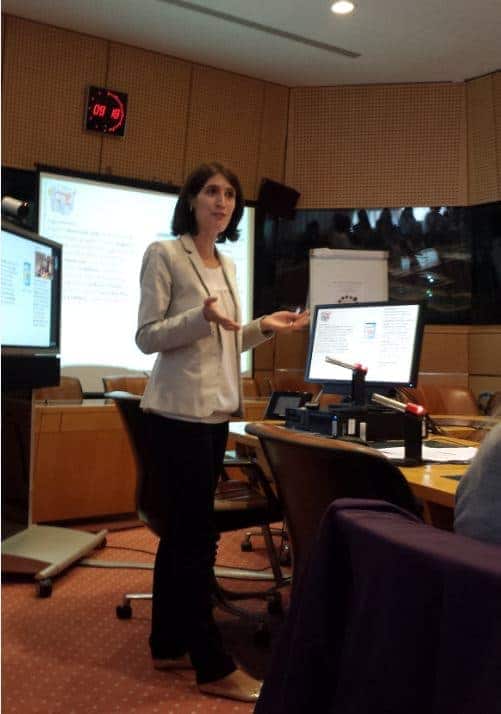 By Vladimir Perkovic
By Vladimir Perkovic
The one hour presentation entitled “The social role of Terminology: challenges of building a termbase to non-specialists” was held in Luxemburg on 5 September 2014 by Ana Rita Remígio of the Universities of Aveiro and Nova de Lisboa. Its aim was to provide translators and terminologists from the European Parliament and the Council of the EU with an opportunity to familiarise themselves with challenges inherent in creating a terminological database destined for the use by non-expert end-users. The main question behind the presentation was: how can terminology help transmit relevant, valid and accurate scientific information to consumers? This is a particularly valid question as terminologists are increasingly aware of the need to disseminate the results of their work beyond the academic or institutional context.
Remígio followed a two-fold approach combining theory and practical work. She used Daniel Gouadec’s model for the translation process to underpin the practical aspects of the creation of a monolingual terminological database in Portuguese on functional foods. The terminological base called AlFαBeta is targeted at non-expert users and, among other things, contains numerous terms found on food labels and their corresponding definitions in an easy-to-understand language suitable for laypeople.
The terminological database is a result of the terminographical process – terminography being the applied field of terminology which addresses the process of building termbases. This terminographical process is organised in three different phases, each of these focusing on distinct objectives:
1. The pre-terminographical phase basically covers the preparatory work. The terminologists are to set the goal to be achieved and to clearly identify the subject field with which the future terminological base will deal. Then the so-called “communicative contexts” are identified i.e. terminologists needs to know what the target public is and what information they want to communicate to the end-user. This “communicative dimension” is differentiated from the “conceptual dimension” (identification, delimitation and representation of the special subject field) and the “textual dimension” (text collection and selection, corpora building and exploration). Once this is clear, specialised corpora need to be created. For the purpose of creating the database on functional foods Remígio identified magazine and newspapers articles, marketing materials, glossaries, project abstracts, food labels, product presentations etc. as the sources of text corpora. In line with the communicative contexts approach she further discussed three groups of authors of such texts: faculty, researchers and science communicators, food industry actors and journalists and then assigned a particular code to each of these groups: CC1, CC2 and CC3 respectively. This is relevant as each of these groups produces texts with a particular communicative intention in mind. Within the context of the present example, i.e. terminological database on functional foods for non-experts, Remígio had to obtain a representative sample of texts for each of the three communicative contexts and build a corpus. Equally a reference corpus of texts targeted at subject field specialists was also developed. Texts were then grouped and analysed according to the communicative context in which they were produced. To accomplish this analysis Remígio used WordSmith Tools by Lexical Analysis Software Ltd. The goal of the analysis was to see if the texts included in the corpus are adequate, if the corpus had been properly designed and, consequently, to assess the need to redesign the corpus.
2. Generally speaking the terminographical phase involves hands-on activities that relate to identification, extraction and production of data that will be included into the terminological base. Firstly, terminologists need to decide on the “architecture” of the base i.e. how term records will be defined. Term candidates from the corpus are then identified, extracted and analysed. This is accomplished with the help of WordList, a software that belongs to the above mentioned WordSmith Tools and, according to the product website lexically.net, is used to have word lists automatically generated in both alphabetical and frequency order. The choice of term candidates was based on two criteria: their belonging to the special subject field and how frequently they occur. Once this stage is completed, definition for each term to be included needs to be written. This task starts with the creation of concordances based on texts from each of the communicative contexts. Finally, the data is validated and inserted into the terminological database.
3. In the post-terminographical phase the terminological database is available and ready to be used. Thus this phase must focus on its continuous updating. The dynamic nature of knowledge necessitates the inclusion of new concepts into the database. The phase equally involves efforts that may result in the commercial or industrial application of the database.
Remígio concluded her presentation with several practical examples of term definition comparison between the AlFαBeta project and IATE. A detailed presentation of her findings, particularly with regard to the theoretical underpinnings of her work, can be found in the article “The Terminographical Process: Phases and Dimensions” published in April 2013 in Volume 58, Number 1 of Meta: Translators’ Journal. Equally Remígio can be contacted at arremigio@ua.pt.
VladimirPerkovic is a Croatian translator and terminologist at the Council of the European Union. The Report was initially targeted at Perkovic’s Croatian colleagues, with the aim of providing them with an overview of Remígio’s presentation and the main findings of her research work.
